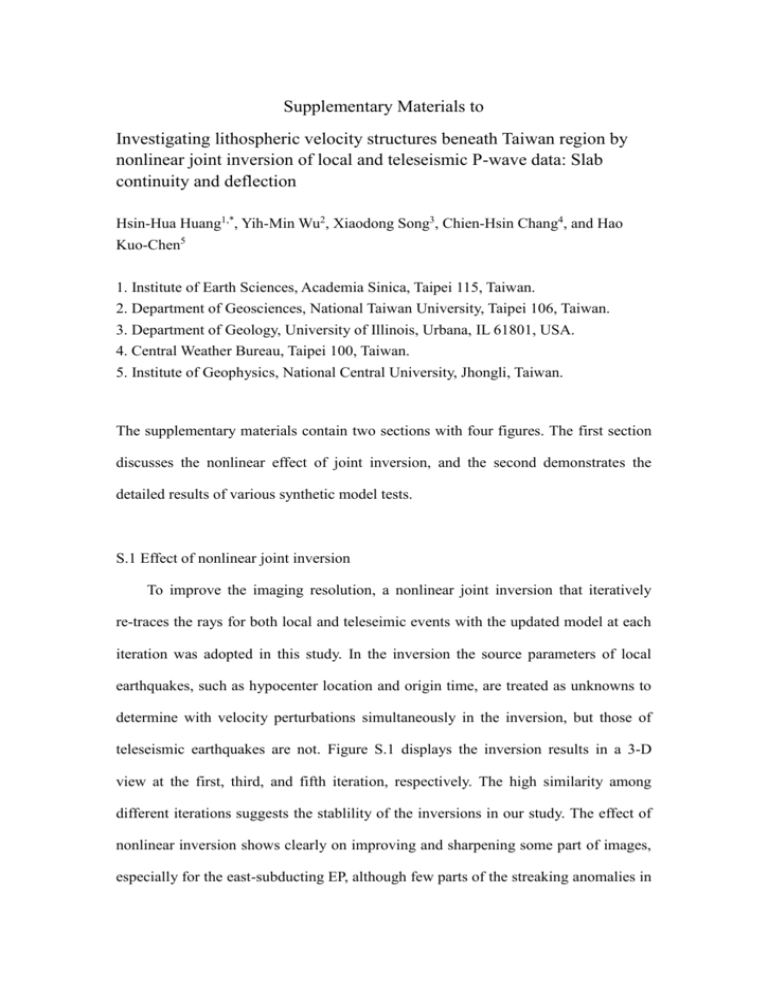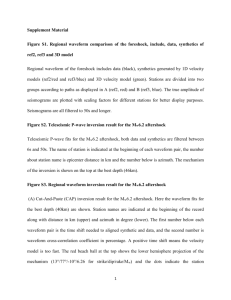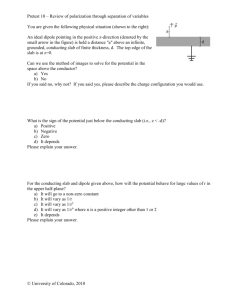Supplementary_rv1
advertisement

Supplementary Materials to Investigating lithospheric velocity structures beneath Taiwan region by nonlinear joint inversion of local and teleseismic P-wave data: Slab continuity and deflection Hsin-Hua Huang1,*, Yih-Min Wu2, Xiaodong Song3, Chien-Hsin Chang4, and Hao Kuo-Chen5 1. Institute of Earth Sciences, Academia Sinica, Taipei 115, Taiwan. 2. Department of Geosciences, National Taiwan University, Taipei 106, Taiwan. 3. Department of Geology, University of Illinois, Urbana, IL 61801, USA. 4. Central Weather Bureau, Taipei 100, Taiwan. 5. Institute of Geophysics, National Central University, Jhongli, Taiwan. The supplementary materials contain two sections with four figures. The first section discusses the nonlinear effect of joint inversion, and the second demonstrates the detailed results of various synthetic model tests. S.1 Effect of nonlinear joint inversion To improve the imaging resolution, a nonlinear joint inversion that iteratively re-traces the rays for both local and teleseimic events with the updated model at each iteration was adopted in this study. In the inversion the source parameters of local earthquakes, such as hypocenter location and origin time, are treated as unknowns to determine with velocity perturbations simultaneously in the inversion, but those of teleseismic earthquakes are not. Figure S.1 displays the inversion results in a 3-D view at the first, third, and fifth iteration, respectively. The high similarity among different iterations suggests the stablility of the inversions in our study. The effect of nonlinear inversion shows clearly on improving and sharpening some part of images, especially for the east-subducting EP, although few parts of the streaking anomalies in the deep depth around the PSP were also enhanced in this way. S.2 Synthetic tests on various slab models S.2.1 Continuous slab model To test the robustness of obtained slab images, we first input three continuous high-Vp slab-like anomalies with different dipping angle, depth range, and slab thickness according to the real-inversion images (Figure 3). Figure S.2 and S.3 show the recovered results in horizontal slices and profiles by local seismic, teleseismic, and joint inversion, respectively. The Slab 1 can be retrieved by the local seismic inversion but not by the teleseismic inversion, and the Slab 2, vice versa, can be imaged by teleseismic inversion mostly but very limited by the local seismic inversion (especially for central Taiwan), demonstrating the distinctly different sensitivities of local and teleseismic data. Due to the subvertical path of teleseismic rays, the teleseismic inversion usually has poor resolution on depth and shows clear smearing effect both upward and downward in the imaging. However, by combination of local and teleseismic data, the joint-inversion can improve greatly the imaging of both Slab 1 and 2, and significantly mitigate the smearing phenomena (see especially on the profile FF’). This test shows not only the characteristics of local and teleseismic data but also promises illustrating the 3-D geometry of slab model beneath Taiwan region. It is worth noting that the teleseismic inversion lowers slightly the Vp values of surrounding areas. This is due to the de-meaning procedure adopted for teleseismic data, which contain only the information of relative lateral variation. In other words, when the teleseismic data are involved, one had better interpret the structures in velocity perturbation rather than in absolute values. S.2.2 Slab break model Modified from the continuous slab models (Figure S.3), we also tested the hypotheses of slab breaks in different dimensions and locations, including models with small and large breaks with ~40-km and ~80-km gaps, respectively, and the foundering model in which we only assumed a lower part of the high Vp anomaly as a dripping structure of the continental eclogitization as proposed by Kuo-Chen et al [2012]. The results show that the foundering model cannot reproduce the upper part of east-dipping high-Vp anomaly we observed in real-inversion images (Figure 3) and may be excluded. For the other two slab break models, the recovered images are mostly similar to those in the real inversion and suggest a resolution limitation in distinguishing the existence of a slab break smaller than ca. 80 km. Only the AA’ profile could resolve the slab break as small as the 40 km with the aid of subduction events in the southern Taiwan. References Kuo-Chen, H., F. T. Wu, and S. W. Roecker (2012), Three-dimensional P velocity structures of the lithosphere beneath Taiwan from the analysis of TAIGER and related seismic data sets, J. Geophys. Res., 117, B06306, doi:10.1029/2011JB009108. Zhao, D., A. Hasegawa, and H. Kanamori (1994), Deep structure of Japan subduction zone as derived from local, regional, and teleseismic events, J. Geophys. Res., 99(B11), 22,313-22,329. Figure captions Figure S.1 The process of the nonlinear joint inversion on structure imaging at the first, third, and fifth iteration, respectively. Figure S.2 Recovery of continuous slab model at different depths. Horizontal slice of 60 km depth shows the locations of profiles for Figure S.3, which are identical to the profile locations in Figure 3. The geometry and location of Slab 1, 2, 3 (synthetic slab-like anomalies) are set upon the tomographic results (Figure 3). Figure S.3 Recovery of continuous slab model in profiles. The profile locations are denoted on 60 km-depth horizontal slice in Figure S.2. The geometry and location of Slab 1, 2, 3 (synthetic slab-like anomalies) are set upon the tomographic results (Figure 3). Figure S.4 Recovery of different slab break models in profiles. They are the small break model (~40-km gap), the foundering model, and the large break model (~80-km gap) from left to right, respectively.






